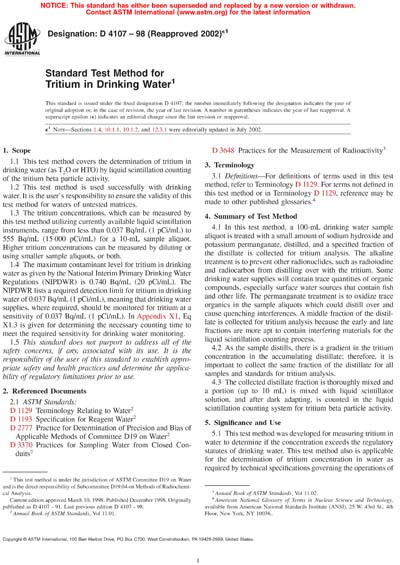Historical
ASTM D4107-98(2002)e1
Standard Test Method for Tritium in Drinking Water
1.1 This test method covers the determination of tritium in drinking water (as T
1.2 This test method is used successfully with drinking water. It is the user's responsibility to ensure the validity of this test method for waters of untested matrices.
1.3 The tritium concentrations, which can be measured by this test method utilizing currently available liquid scintillation instruments, range from less than 0.037 Bq/mL (1 pCi/mL) to 555 Bq/mL (15 000 pCi/mL) for a 10-mL sample aliquot. Higher tritium concentrations can be measured by diluting or using smaller sample aliquots, or both.
1.4 The maximum contaminant level for tritium in drinking water as given by the National Interim Primary Drinking Water Regulations (NIPDWR) is 0.740 Bq/mL (20 pCi/mL). The NIPDWR lists a required detection limit for tritium in drinking water of 0.037 Bq/mL (1 pCi/mL), meaning that drinking water supplies, where required, should be monitored for tritium at a sensitivity of 0.037 Bq/mL (1 pCi/mL). In , Eqn. 1 is given for determining the necessary counting time to meet the required sensitivity for drinking water monitoring.
1.5 This standard does not purport to address all of the safety concerns, if any, associated with its use. It is the responsibility of the user of this standard to establish appropriate safety and health practices and determine the applicability of regulatory limitations prior to use.
ASTM International [astm]

